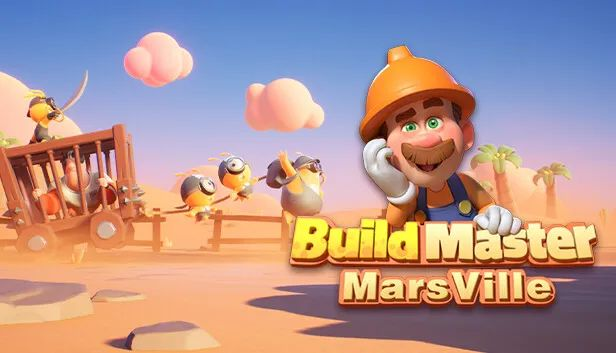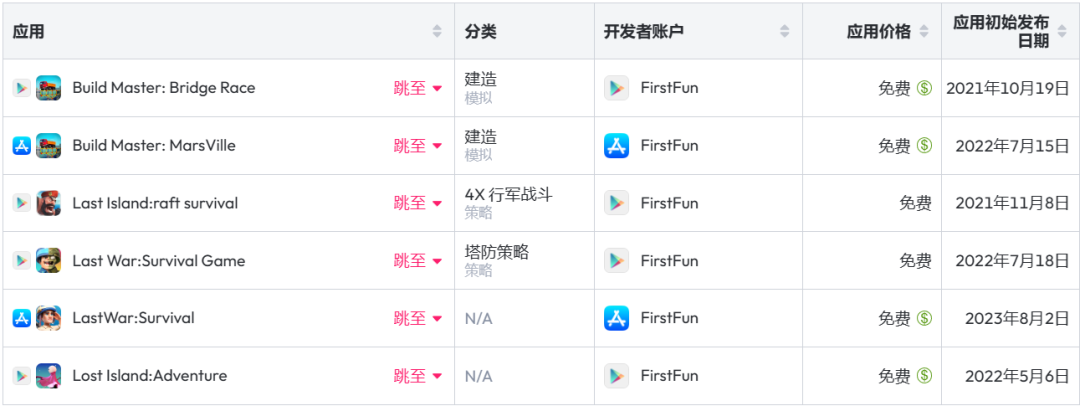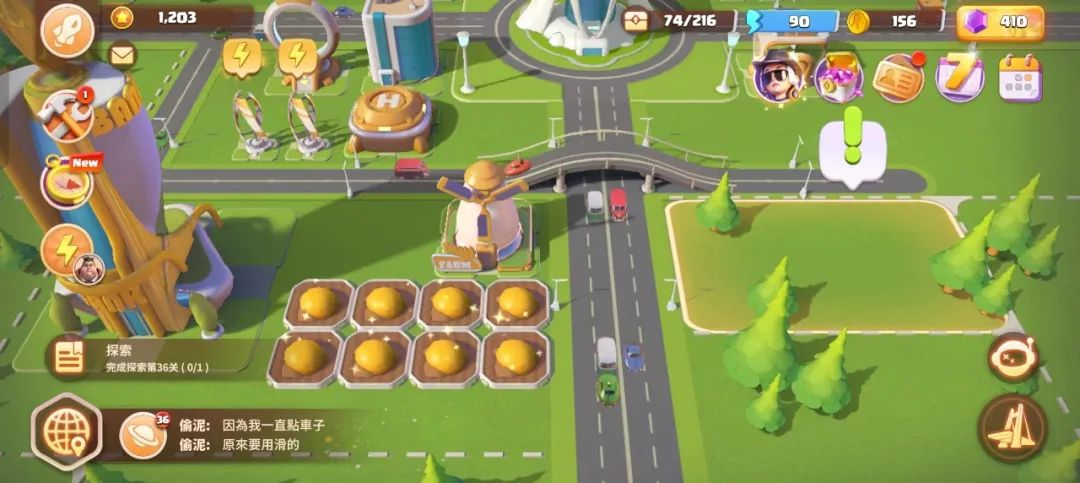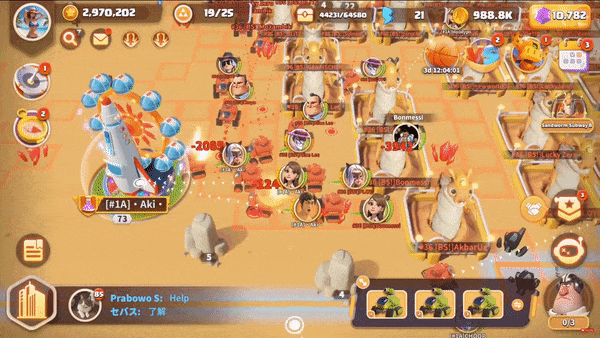

扬帆出海APP

微信小程序
{{!completeInfo?'请完善个人信息':''}}
精准高效领先的融资对接服务


Recently, while I was browsing the app store rankings, I stumbled upon a simulation building game called "Build Master: Marsville."


Recently, while I was browsing the app store rankings, I stumbled upon a simulation building game called "Build Master: Marsville." This game has maintained a spot in the top 10 rankings in over 20 countries, including Mongolia, Italy, and Turkey, for a whole month. Moreover, it has recently climbed to the top 3 on the game download charts and the top 10 on the overall sales charts in regions such as Cambodia and Turkey. Upon opening the game store page, both the game logo and related images prominently feature a realistic bridge-building gameplay style. Interestingly, the official game description emphasizes that this is an SLG (Simulation and Strategy) game, which has piqued my curiosity.

Of course, as secondary gameplay elements have become increasingly popular among mid to heavyweight game developers, more and more game companies have been prominently featuring popular secondary gameplay elements as visible labels on game interfaces and in app stores. It's evident that "Build Master: Marsville" has adopted a similar approach. However, what surprised me the most is that the image display provides no glimpse of the SLG content beyond bridge building. Even more intriguing is that the publisher, FirstFun, previously released a game called "Last War: Survival Game," a combination tower defense game that directly incorporates and modifies elements from "Top War" as icons. This discovery has certainly piqued my interest.

What's the background of FirstFun, and how did "Build Master: Marsville" manage to stand out in the competitive SLG arena?
PART.01 The Mystery Publisher Turns Out to Be an SLG Veteran
Given FirstFun's surprising use of a modified "Top War" icon, I decided to dig deeper into FirstFun. The name "FirstFun" may sound unfamiliar and enigmatic, but according to their official website, FirstFun is the alter ego of Yuanqu Entertainment, founded in 2020, headquartered in Beijing, and focusing on games and social platforms as its core business.

According to their past work descriptions on their official website, it's evident that Beijing Yuanqu Entertainment has published numerous well-known titles that many of us are familiar with. Most of these titles are still ranked among the top games in the market. Some of these titles include "Last Shelter," "Clash of Kings," "Rise of Empires," "Top War," along with the recently released titles "Build Master: Marsville" and "Last War: Survival Game" (launched in July 2022). In addition, Beijing Yuanqu Entertainment has a subsidiary named Shanghai Yuanqu Entertainment Co., Ltd., and they conducted overseas testing for a low-poly styled open-world sandbox game called "Zero-based World" in Shanghai.

Being able to secure the publishing rights for so many prominent products is a testament to the significance of Beijing Yuanqu Entertainment. After some investigation, it is evident that Beijing Yuanqu Entertainment is undeniably part of the "Zhi Ming Xing Tong" (Smart Star Pass) ecosystem. To start with, Beijing Yuanqu Entertainment was founded by the former CEO and co-founder of Smart Star Pass, Xie Xianlin. The company has received investments from Tencent and Challenger Capital. According to enterprise information, Beijing Yuanqu Entertainment is co-owned by Xie Xianlin's Beijing Yuanqu Technology, with an 89.29% stake, and Tencent, with a 10.71% stake.

Apart from Tencent's involvement in the investment, Beijing Yuanqu Entertainment has received funding from Challenger Capital, founded by Tang Binsen, during its Pre-A and A rounds. Notably, Tang Binsen is also one of the co-founders of Smart Star Pass. It's worth mentioning that Challenger Capital has invested in over 100 startup companies, with total assets under management reaching 5 billion RMB. In the realm of gaming investments, Challenger Capital primarily invests in teams involved in the SLG field, including Beijing Yuanqu Entertainment, Long Chuang Yuedong, and Jiangyu Interactive.
Currently, while the exact amounts of their investment rounds in Beijing Yuanqu Entertainment remain undisclosed, considering the investment trends in similar SLG companies, it's possible that a single investment round exceeded tens of millions, and with Tencent's two investments, the total investment may have approached or exceeded 100 million RMB.

Furthermore, it's essential to highlight that Xie Xianlin also holds shares in two prominent SLG companies: Long Chuang Yuedong (12.5375%) and Jiangyu Interactive (36.5318%). The founders of both companies, Su Lilong of Long Chuang Yuedong and Wu Lingjiang of Jiangyu Interactive, are core members of Smart Star Pass. They received investments from Smart Star Pass in the early stages of their entrepreneurial endeavors. Long Chuang Yuedong (IM30) is known for representative products like "Last Shelter," "Last Empire-War Z," and "Rise of Empires." Jiangyu Interactive's flagship product is "Top War."
The close ties between Long Chuang Yuedong, Jiangyu Interactive, and their association with Smart Star Pass, combined with strong financial backing and Xie Xianlin's significant experience, explain why FirstFun has been able to secure the distribution rights to these popular products. They showcase these products as their representative titles on their official website and even incorporate elements of the "Top War" IP into the release of products like "Last War: Survival Game" and other titles with IP attributes.

This includes our main focus today, "Build Master: Marsville." While it might seem like a product centered around bridge and road construction at first glance, it also incorporates 4X strategy elements in its gameplay. "Top War" pioneered the combination of 4X SLG with casual gameplay, which has already been proven successful in the overseas market. "Build Master: Marsville" innovatively extends its reach into the simulation category, an area that few SLG products have ventured into.
PART 2: The "SLG+" trend has finally made its way to the simulation genre.
In "Build Master: Marsville," you'll notice that the realistic-looking screenshots in the store can be quite misleading. The game's actual art style follows a globally popular European and American cartoon style that has a broad audience appeal in global markets. The game's theme taps into a recent hot topic – extraterrestrial migration and Mars exploration.
To give you an idea of how hot this topic is, Elon Musk recently detailed his Mars migration plan on his website. However, the possibility of Mars migration within the next two years is still uncertain. In "Build Master: Marsville," players can experience life on a distant planet ahead of time.

"Build Master: Marsville" is set in the future, where Earth has long been uninhabited. As a player commanding the city's reconstruction, you must return to Earth and rebuild cities. During the reconstruction, interstellar pirates have planted explosives on your ship. You must find the pirates and recover the password needed to defuse the bomb within a limited time. In this aspect, "Build Master: Marsville" shares a similar setting with "Whiteout Survival." The countdown to the bomb explosion in "Build Master: Marsville" is reminiscent of the incoming blizzard in "Whiteout Survival," both creating a sense of urgency that immerses players quickly in the game.

In this context, players must gradually track down the location of the pirates through level-designed road construction and bridge-building gameplay and engage in battles with the pirates. Simultaneously, they must establish a base and work towards the goal of city reconstruction.
The core gameplay can be roughly divided into three parts: simulation management, adventure battles, and SLG resource competition/team battles. Upon overall experience, simulation management and adventure gameplay play a significant role. The simulation management is reflected in base construction and city rebuilding. "Build Master: Marsville" features a grid-based map, which sets it apart from other SLGs with its more expansive and sandbox-style gameplay, providing a feeling closer to a pure simulation sandbox game.

On these grid-based maps, players not only need to gradually unlock plots of land to construct a range of buildings for survival and combat, much like in farming games, but they also have to collect resources for planting crops, running farms, and even undertaking civil engineering projects like building roads, parks, and skyscrapers. Based on the author's gaming experience, "Build Master: Marsville" can almost be seen as a complete simulation and management game, with a richness of content, systems, and practical experiences that even bear some resemblance to "Cities: Skylines" and "Happy Farm."

To upgrade and unlock more plots of land and buildings, players need to acquire resources through small resource levels that have tree-cutting gameplay at their core. Regarding character progression, "Build Master: Marsville" also features a category of small mobile combat levels where players can independently move and select 2-3 characters for battles, earning a significant amount of experience in the process.

In the exploration levels, players can experience the road construction and bridge-building gameplay as well as card-based combat, which are prominently featured on the in-game store page. "Build Master: Marsville" adopts a level-based approach in its adventure mode, which serves as the main storyline of the game. Road construction and combat levels are interwoven, but road construction levels make up a larger proportion. On average, several road construction levels are encountered before a combat level. While special levels and small boss levels can provide items required for building upgrades and trigger plot progression, the rewards in other regular levels are mainly in the form of coins, making them relatively uniform in comparison. However, the content in the road construction levels is quite diverse, with various elements such as planks, balloons, scales, teleporters, and more gradually unlocking as players progress through the levels.

However, the main storyline levels are closely tied to building levels and character combat power. As the number of levels increases, players need to strategically upgrade their core base buildings, and the combat levels are mainly reliant on numerical values. They have specific requirements for character combat power. Players must continuously upgrade their characters or summon more powerful heroes through the summoning system to meet these demands.

At this point, you can feel how the gameplay elements of simulation and management, exploration levels, and combat are interconnected. Simulation and management require obtaining resources through exploration and combat, and both exploration and combat necessitate continuous upgrading of buildings and increasing combat power to obtain more abundant resources. The overall experience is that the early-game pace is relatively fast, both in terms of resource acquisition and building upgrades. In comparison to other casual SLG games, "Build Master: Marsville" progresses more swiftly, often without the need to wait for building upgrades. The game has a low barrier to entry and a variety of gameplay experiences introduced quickly, making it quite engaging and able to attract a large number of players in the early stages.
However, in contrast, the gameplay design for the combat part in "Build Master: Marsville" is somewhat one-dimensional. The combat experience heavily relies on the rarity and numerical values of the characters, creating a noticeable gap in the experience for casual players. Furthermore, both resource acquisition and level progression depend heavily on combat levels, which further pressures players to spend money on gacha and character development in order to obtain powerful characters and advance in the game. In the end, it may become a game primarily about maximizing stats, and while it does encourage player spending to some extent, it could potentially affect player retention.

Speaking of which, it's impossible not to mention the summoning system in "Build Master: Marsville." Perhaps to better align with the aesthetic preferences of Western players, the game has incorporated some clever ideas in the appearance and names of certain characters. For instance, the featured character on the summoning page is none other than the beloved Chinese martial arts legend, Bruce Lee, which would likely resonate with European and American players. Among the doctor companions that players can obtain through exploration levels is one named Scarlett... Regardless, this gacha design is certainly attention-grabbing and represents a good design approach.

As for the SLG gameplay, it's not fully revealed until the mid-game when the task advances to constructing a "radar" which allows players to detect the world's large map and other players. The overall SLG gameplay adopts a relatively basic Cok-like (Clash of Kings-like) model. The world map is divided into squares, and what's distinctive is that each square has a relic that can be contested. Major player alliances can compete for control of these relics. In addition, players can engage in team battles and alliance warfare, providing an experience similar to "team battles" and "large map skirmishes" often found in SLG games. Overall, there isn't a particularly innovative design, but features like relic contention and large map skirmishes do add some differentiation and help compensate for the somewhat monotonous combat gameplay.

In terms of the SLG gameplay, it only becomes fully apparent in the mid-game when the game progresses to the construction of a "radar," which allows you to explore the world's large map and locate other players. The overall SLG gameplay follows a relatively basic Cok-like (Clash of Kings-like) model. The world map is divided into squares, and what's unique is that each square features a relic that can be contested. Major player alliances can compete for control of these relics. Additionally, players can engage in team battles and alliance warfare, providing an experience similar to "team battles" and "large map skirmishes" commonly found in SLG games. Overall, there isn't particularly innovative design, but elements like relic contention and large map skirmishes do introduce some differentiation and help alleviate the somewhat monotonous combat gameplay.

From the perspective of the in-app purchase pricing in "Build Master: Marsville," it seems that the game is positioned as more of a casual experience. The pricing is relatively conservative, which might be in consideration of the game's casual orientation. Based on the purchasing preferences of international players, they do tend to favor lower-priced packages, and their overall spending behavior tends to be rational and restrained.

PART 3: Road Construction and Bridge Building - A Master of User Acquisition
Whether it's a more casual simulation and management game or a heavier SLG, user acquisition marketing is an essential aspect of game promotion. "Build Master: Marsville," which possesses attributes of both genres, naturally has certain advantages in user acquisition.
The fact that the game can directly feature road construction and bridge building on its storefront is a clear indication of "Build Master: Marsville's" recognition of this popular gameplay element. Therefore, in terms of user acquisition and marketing, the game has produced a significant amount of promotional materials centered around this gameplay. According to extensive data, "Build Master: Marsville" began its advertising campaign on October 29th last year. As of now, it has deployed nearly 280,000 ads on both Android and iOS platforms. In addition to traditional advertising channels, the game has notably utilized in-game and in-app ad placements through Google Ads (Admob), UnityAds, and ironSource.

In popular promotional copy for "Build Master: Marsville," it's evident that the game doesn't highlight its SLG gameplay as a core selling point. Instead, the focus is on showcasing the simulation and bridge-building exploration gameplay with slogans like "Can you complete the bridge?" and "Define your city freely."

Additionally, it's worth noting that there's a significant amount of content related to the bridge-building and road construction gameplay of "Build Master: Marsville" on TikTok. Many of these videos use the #buildmaster hashtag, and the total view count for videos under this hashtag exceeds 700,000. While there are also many unrelated videos in this hashtag, "Build Master: Marsville" has undeniably benefited from the visibility generated by this trending tag.

Overall, the high-quality gaming experience brought by both the bridge-building and road construction gameplay as well as the simulation and management elements, coupled with effective user acquisition materials, have translated into a broader user base and a continuous stream of downloads for "Build Master: Marsville."
Despite being launched in July 2022, it's worth noting that, according to incomplete statistics, "Build Master: Marsville" continues to achieve monthly download numbers exceeding one million over the past three months. Furthermore, these numbers are achieved separately on iOS and Android platforms, with downloads exceeding one million each. In particular, in both July and September, downloads on both platforms surpassed 1.2 million, and the combined revenue for both platforms in September reached nearly $2.8 million. Considering that "Build Master: Marsville" emphasizes a simulation and management gaming experience and its in-game package pricing is not particularly high, achieving a monthly revenue of nearly $2.8 million is quite impressive. In summary, "Build Master: Marsville" can be considered a significant force in the SLG+ casual gaming category that cannot be ignored.
PART 4:Conclusion
In the current landscape where the 4X strategy genre is facing a decline and there's a shortage of new blockbuster titles, "Build Master: Marsville" stands out with its unique approach of combining light SLG elements with strong casual simulation and management gameplay. This approach undoubtedly brings some fresh excitement to the gaming market. The fact that the game has maintained its success over a year since its launch demonstrates the significant potential of this kind of micro-innovative approach.
Furthermore, "Build Master: Marsville" has recognized the market potential of multi-platform releases and has already made its appearance on Steam. From this perspective, it's evident that both "Build Master: Marsville" and its developer, Beijing Youzu Interactive, have a strong presence in the global gaming scene. They are both deserving of our long-term attention and observation.

Going forward, we look forward to "Build Master: Marsville" potentially surpassing its current limitations. This could include making more reasonable adjustments in areas like game combat. We'll also keep an eye on whether, after the potential of this gameplay style becomes evident, the market will continue to offer us more similar products and surprises.
·END·
文章作者:Sailing Global
版权申明:文章来源于Sailing Global。该文观点仅代表作者本人,扬帆出海平台仅提供信息存储空间服务,不代表扬帆出海官方立场。因本文所引起的纠纷和损失扬帆出海均不承担侵权行为的连带责任,如若转载请联系原文作者。 更多资讯关注扬帆出海官网:https://www.yfchuhai.com/

{{likeNum}}
好文章,需要你的鼓励
文章热榜
 已关注
已关注
 关注
关注

微信号:yfch24



微信号:yfch24
小程序


公众号

社群















